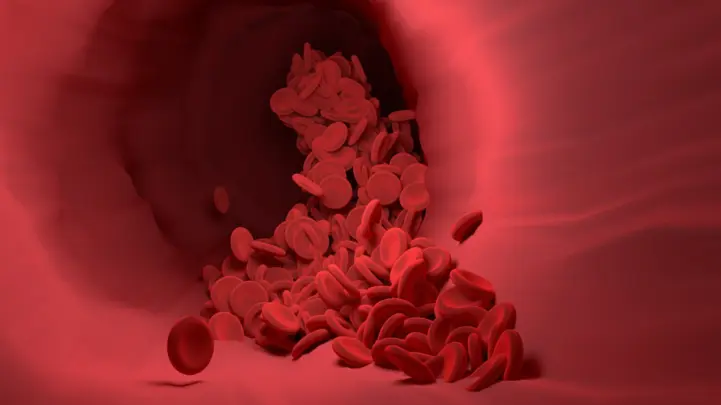Blood test uses 'protein clock' to predict risk of Alzheimer's disease and other diseases
A lifetime "clock" based on about 200 proteins found in the blood can predict a person's risk of developing 18 chronic diseases, including heart disease, cancer, diabetes and Alzheimer's disease. Lead scientist Austin Argentieri, a population health researcher at Massachusetts General Hospital in Boston, says the clock's accuracy raises the prospect of developing a single test that could describe a person's risk of developing many chronic diseases.
Aging

A person's chronological age is key to determining their risk of many age-related diseases. But chronological age is not an ideal indicator of disease. For example, some 60-year-olds have weakness and heart disease, while others are healthy. There is evidence that protein aging is a common trait that underlies a large variety of traits associated with physical function, impairment, and cognitive status, as well as biomarkers of aging (e.g., telomeres and IGF-1). Studies have reported that although age is not associated with telomere length25, protein aging is strongly inversely related to telomere length, the main cellular feature of aging. It is worth noting that there is comprehensive and well-supported evidence proving that protein aging is a reliable indicator of multiple mortality and morbidity, and is associated with the future risk of all fourteen non-cancerous diseases studied and four common types of cancer (esophageal, prostate, lung cancer, etc.). Newer DNAm clocks were later developed that are not trained for chronological age itself, but rather are trained to predict composite apparent age variables that are usually weighted combinations of age and biomarkers of disease (e.g., recent research using kidney and heart tissue in mice, as well as brain tissue in humans and rhesus macaques, showed that age-related changes in mRNA and protein levels were not strongly correlated. Examples The main proteins are very important and whose abundance is not well related to mRNA are ECM proteins such as elastin (ELN) and collagen (COL6A3). These proteins have a long half-life that makes them particularly vulnerable to age-related degradation, contributing to structural tissue damage that occurs during aging. Argentieri and his colleagues sought to build a "clock" that accurately reflected a person's illness status. To do this, they used data from 45,441 randomly selected people at the UK Biobank, a biomedical sample warehouse. The sample size is about 30 times larger than that used in a previous protein clock study2, making it statistically more robust.
Recommend
How to kill the "zombie" cells that cause aging

The team found that levels of 204 proteins accurately predict chronological age. Remarkably, when the authors built a second clock using only the most significant 20 proteins, it predicted age almost as well as a 204-protein clock. The twenty proteins included elastin and collagen, which form the structure of intercellular support, and proteins involved in immune response and hormone regulation. The watch also accurately predicted the chronological age of two other groups of people: nearly 4,000 shareholders in a vital bank in China and nearly 2,000 shareholders in a vital bank in Finland. The researchers say previous protein-based watches looked at data from more homogeneous populations. In general, the age measured using a protein clock was similar to chronological age. But for some individuals, there was a gap between the two – reflecting the fact that protein levels change as the disease progresses. People whose protein clock age was higher than their chronological age were more likely to develop 18 chronic diseases, including diabetes; neurodegenerative conditions; cancer; and heart, liver, kidney, and lung disease. Aging of the protein clock has also been associated with physical weakness, slow reaction time and premature death. Other people's proteins age slower than average. It is unclear whether this is due to environmental factors, genes or a combination of them. Argentieri says that of the 10 percent of people surveyed who were "the slowest ageing," "less than 1 percent developed dementia or Alzheimer's.
Are we going back in time?

Molecular epidemiologist Sarah Haag at the Karolinska Institute in Stockholm says two of the strengths of the study are the huge data set it contains and the success of replicating it in diverse populations. "It's a very powerful study." Argentieri and his colleagues want to add more geographic and genetic diversity to their training data. Argentieri says the determining factor is the lack of protein data in biobanks with diverse populations. The authors are also investigating the use of their protein clock to test whether new medical treatments prevent age-related illnesses "without having to wait a decade or two to see if someone will develop chronic disease." Finally, they look for environmental and behavioral factors that influence the speed at which proteins age in the body. "Well, you can tell me about my future risk of 18 different diseases," says Argentieri. "But can I do anything to change this trajectory?" The development of protein aging clocks can be used as a reliable tool to identify biological mechanisms that are involved in multiple diseases, and may serve as useful tools to identify protein targets for potential drug therapy or lifestyle modification to reduce premature mortality.
![]()
How to deal with difficult people and people with a capricious mood?
How to deal with difficult people and people with a capricious mood? more- ADVERTISEMENT
![]()
The Star Marvel: Discovering the Extraordinary in the Milky Way
The star marvel of the Milky Way dazzles with its vivid colors, sparkling structures, and deep mysteries. It's a celestial masterpiece that has inspired scientists and artists alike, blending beauty, culture, and cosmic curiosity into one extraordinary galaxy. more- ADVERTISEMENT
![]()
The most expensive paintings that you could have painted yourself
The Most Expensive Paintings You Probably Could Have Painted Yourself more- ADVERTISEMENT
![]()
Habits that make you smarter
Becoming smarter isn’t about talent—it's about building habits that boost your brain. Exercise, mindfulness, learning new skills, and reading can sharpen your mind. Add good sleep, social interaction, and goal setting, and you're on your way to a smarter, healthier you. Intelligence grows with consistent practice. more- ADVERTISEMENT
![]()
Our cosmic neighborhood may be ten times larger than we thought.
A massive discovery suggests our Milky Way may belong to a cosmic structure far bigger than we thought—possibly ten times larger than the Laniakea supercluster. Galaxies travel like rivers in a gravity basin, flowing toward the enormous Shapley concentration, challenging everything we thought about the universe’s scale. more- ADVERTISEMENT
![]()
How to price your product? Best Pricing Strategies
Finding the right price for your product is key to profit and customer satisfaction. Try different strategies—like cost-based, value-based, or psychological pricing—and stay flexible. There's no one-size-fits-all method, but aligning your price with customer needs and market factors is the smart move. more- ADVERTISEMENT
![]()
Steve Jobs: Courage is what separates actors and dreamers
Steve Jobs: Courage is what separates actors and dreamers more- ADVERTISEMENT
![]()
Black holes are common, so where are white holes?
White holes, theoretical opposites of black holes, may spit out matter but remain undetected. Though allowed by Einstein’s equations, they defy common physics and lack evidence. Some physicists now wonder if a dying black hole might transform into a white hole—an idea tied to solving deep cosmic mysteries. more- ADVERTISEMENT
![]()
The best economical graphics cards for gaming and content creation - available in the Arab world
Looking for strong gaming and content creation performance on a budget? The NVIDIA GeForce GTX 1660 Super and RTX 3050 stand out for 1080p, while the AMD RX 6700 XT and NVIDIA RTX 3060 Ti shine at 1440p. Great value options packed with smooth performance and essential features like ray tracing. more- ADVERTISEMENT
![]()
Unexplained phenomena - a list that drives you crazy!
Marfa lights, glowing mysteriously in Texas deserts, and intricate crop circles bent into fields with no clear cause, both baffle scientists and spark theories from the natural to the supernatural. The Bermuda Triangle, too, remains a hotspot of intrigue, with ships and planes vanishing, leaving only questions and fascination behind. more- ADVERTISEMENT





















